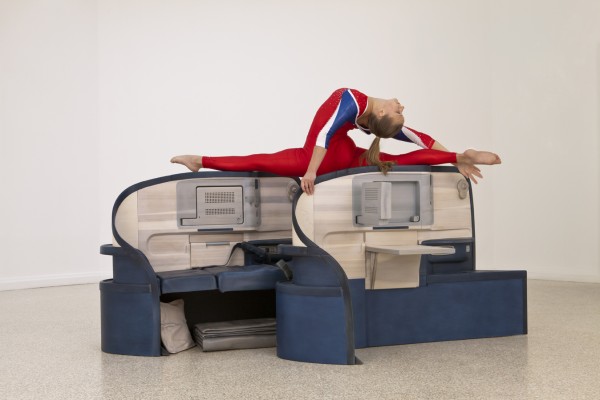Allora & Calzadilla
Saturday, 31 March 2012
Allora & Calzadilla
Work from “Body in Flight“.
“The performances for Body in Flight, beginning every hour on the hour, will last 15-20 minutes. That length of time, Allora notes, is a big departure from the typical, 2-to-3-minute gymnastics routine. “We’re slowing things down, stretching them out,” she says, “taking things that you know and making them strange.”
The artists also point to the fact that the airline seats partially obstruct the public’s view of the athletes, something that real gym equipment would never do. “There are moments where you just see a head, or a hand or an arm, because of the way the seat intersects the body of the performer,” Allora explains. The result is a kind of “perverted or contaminated gymnastics,” as Calzadilla describes it. To develop the movements, Allora & Calzadilla worked with choreographers as well as coaches from USA Gymnastics. The artists have previously used dance in their work Compass (2009). Conceived for the Temporäre Kunsthalle Berlin, this project featured a dropped ceiling that separated dancers from an audience; the result was a dance performance that could be heard but not seen.
Ideas from conventional sculpture are also in play. The artists say that they were thinking about Brancusi’sBird in Space (1923), with its aerodynamic form that seems to take flight from the pedestal. In this case, the pedestal (the seat) also has a close relationship to the Pop object and the readymade. The business-class chair, Allora says, represents “an advanced form of industrial design, the ultimate commodity fetish.”
Another consumerist chaise, the tanning bed, is the focus of a sculpture installed in the pavilion’s rotunda. Its inhabitant is not a live human, but an altered bronze replica of the statue that crowns the U.S. Capitol Building. Titled Armed Freedom Lying on a Sunbed, the piece will call attention to the architectural parallels between the pavilion and the Capitol (and may also bring to mind certain politicians with perma-tans).
Algorithm, the other sculpture, is more interactive. It combines a custom-made pipe organ with a functional automatic teller machine; the ATM will generate a unique musical score for each transaction performed.
The Venice projects have a close relationship to the couple’s recent performance piece Stop, Repair, Prepare: Variations on “Ode to Joy” for a Prepared Piano, which delighted audiences and impressed critics when it was presented in 2008 in the atrium of New York’s Museum of Modern Art. It involves a musician performing part of Beethoven’s Ninth Symphony while standing in a hole in a modified grand piano and slowly walking it around the space. In both cases, the artists are inducing trained professionals to relearn their crafts, but with a twist—the piano must be played backwards and from behind the keys, the balance beam walked with slopes and curves. “We’re asking them to reinvent their skills, or to use their skills to make new gestures or forms that are not part of their standard vocabulary,” Allora says. “And this idea of re-skilling doesn’t end with the performer,” Calzadilla adds. “The public is asked to re-skill its way of viewing.”
“You have modern choreographers, professional athletes, artists working together. It feels incredibly avant-garde,” says Lisa Freiman, senior curator of contemporary art at the Indianapolis Museum of Art and commissioner of the U.S. Pavilion. “They’re creating a new language for art.”
Despite the show’s experimental nature and ambiguous allusions to geopolitics, the artists’ Biennale proposal had strong support from the State Department (its Bureau of Educational and Cultural Affairs has a role in selecting the country’s representative). “At this moment in time, with all of the conflicts going on around the world, their project is one of the most important statements that the United States could make in an international context,” Freiman asserts. “So much of Allora & Calzadilla’s work deals with conflict—whether it’s esthetic, social or political—played out in physical form.”’ – Art in America



